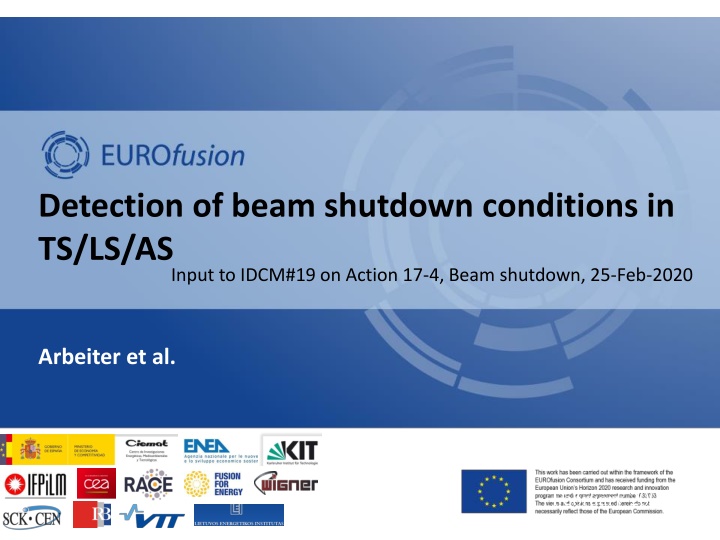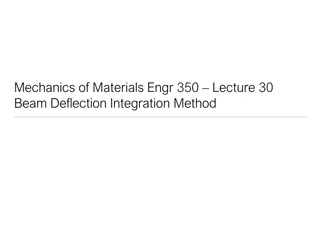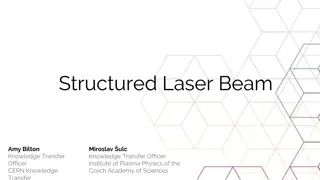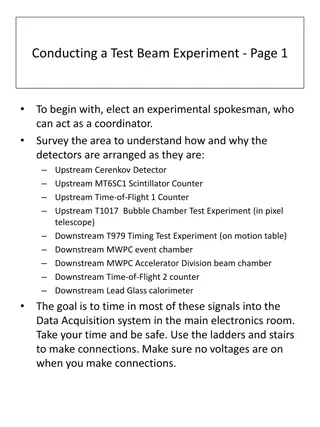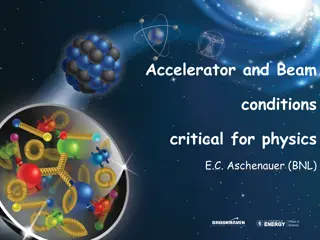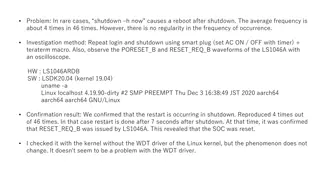Analysis of Beam Shutdown Conditions in IDCM Input to Action
This comprehensive document explores the detection of beam shutdown conditions in the context of an IDCM input to Action. It covers scenarios requiring beam shutdown, available detection techniques, sensor compilation, and allocation of detection techniques. The analysis delves into the power source, thermal energy conversion, neutron and gamma deposition, and potential scenarios leading to beam shutdown. Detailed scenarios related to lithium loop flow, heat sink seizure, lithium loss, vacuum chamber issues, and disturbance evolution on the lithium surface are discussed.
Download Presentation

Please find below an Image/Link to download the presentation.
The content on the website is provided AS IS for your information and personal use only. It may not be sold, licensed, or shared on other websites without obtaining consent from the author.If you encounter any issues during the download, it is possible that the publisher has removed the file from their server.
You are allowed to download the files provided on this website for personal or commercial use, subject to the condition that they are used lawfully. All files are the property of their respective owners.
The content on the website is provided AS IS for your information and personal use only. It may not be sold, licensed, or shared on other websites without obtaining consent from the author.
E N D
Presentation Transcript
Detection of beam shutdown conditions in Input to IDCM#19 on Action 17-4, Beam shutdown, 25-Feb-2020 TS/LS/AS Arbeiter et al. February 2005
Structure of action 1. Identification of scenarios which require a beam shutdown (BSScnXX) (RAS, others) . (19 scenarios documented) 2. Discussion of available detection techniques 3. Compilation and completion of list of sensors in TS/LS/AS 4. Allocation of detection techniques to BSScn. Important characteristic : time-scales of (a) detection vs. (b) specific system degradation Action is still ongoing. F. Arbeiter | Signals to effect beam shutdown| 25-Feb-2020 | Page 2
The power source Under normal operation conditions, the beam transports a power P=5MW (by 125mA of D+ particles at 40MeV) to the target on an area of 200x50mm (q =0.5E9 W/m ), alternatively 100x50mm (q =1.0E9 W/m^2). This large (particle) power is converted to thermal energy in the flowing lithium, dominantly in the Bragg peak ~19..20mm below the Li free surface (q =8E10 W/m ). The Li bulk temperature increases by T = P / (U tb cLi) = 24 K (Flow velocity U, jet thickness t) . The generated neutrons,gammas+secondary gammas deposit O(100 kW) in the TC components, in the HFTM qm=2..3 W/g, q =16..24E6 W/m ABDFN | Meeting on IDCM Action 18-3, Be7 issues| 27-02-20 | Page 3
Part I : List of Beam Shutdown Scenarios (BSSc) F. Arbeiter | Signals to effect beam shutdown| 25-Feb-2020 | Page 6
Conditions to be avoided/detected (general) AS-related: Overpower in the D+ beam Decrease of beam footprint area Misplacement of beam centroid (scrapers, beam tubes, LT-frame) Excessive scattering of beam (i.e. gas ingress but severity not clear) increase of q ) LT/LS-related: Reduction of Li flow thickness Reduction of Li flow velocity Increase of Li inlet temperature to the LT Mechanical break TC-component (HFTM, STUMM, TC-Liner, TC-bioshield) related: Direct exposure to beam after LT failure Reduction of coolant mass flow rate, Increase in coolant inlet temperature Mechanical break F. Arbeiter | Signals to effect beam shutdown| 25-Feb-2020 | Page 7
Scenarios concerning LT/LS N. Description BSSc LS01 RAS#1, FLIL1 : Loss of flow in the Lithium Loop due to EMP trip. Category III BSSc LS02 RAS#2, HLIL1 : Loss of heat sink for removal of heat loads from Li loop due to seizure of the Secondary Loop pump, Categoty V BSSc LS03 RAS#3, LLLA1: Loss of lithium in Lithium Loop Area due to large break at the electromagnetic pump outlet, Category IV BSSc LS04 RAS#4, LTTC1, Loss of lithium in the TC due to large break in piping running inside the cell, Category V BSSc LS05 RAS#5, VTVC1, Loss of vacuum in Target Vacuum Chamber, Category III Evolution of large scale waves/wakes (gravity waves) on the Li surface s>2mm by growing disturbance (i.e. deposits, oxides) on the nozzle outlet BSSc LS06 ABDFN | Meeting on IDCM Action 18-3, Be7 issues| 27-02-20 | Page 8
Scenarios concerning TS N. Description BSSc TS01 RAS#6, LHFM1, Loss of helium gas from HFTM cooling circuit inside TC, Category IV BSSc TS02 RAS#7, FHCSLP1, Loss of flow in the TC-HCS-LP due to spurious valve closure, Category II BSSc TS03 RAS#8, LHFTM2, Loss of helium gas from HFTM cooling circuit inside the cooling room hosting TS-HCS-LP equipment, Category III BSSc TS04 RAS#9, FWCS1, Loss of water flow in the TC-WCS due to spurious closure of isolation valve in the loop hot leg, Category II BSSc TS05 RAS#10, LWCS1, Loss of cooling water from TC-WCS circuit inside the room hosting the TC-WCS equipment, Category III BSSc TS06 Increase of HFTM capsule temperature +15K over setpoint [HFTM DDD sect 4.6] BSSc TS07 Increase of HFTM body temperature +15K over nominal level [suggestion] BSSc TS08 Increase of TC liner temperature +15K over nominal level [suggestion] F. Arbeiter | Signals to effect beam shutdown| 25-Feb-2020 | Page 9
Scenarios concerning AS N. Description BSSc AS01 RAS#12, LAF1, Cooling water ingress in the accelerator beam duct, Category III BSSc AS02 RAS#13, VAF, Loss of vacuum in beam duct and air ingress, Category III BSSc AS03 RAS#14, GAF, Loss of D2 or H2 into the Accelerator Vault due to rupture of gas supply system, Category III BSSc AS04 RAS#15, VIS, Loss of vacuum in ion source due to containment rupture, Category III BSSc AS05 Overpower on beam scrapers BSSc AS06 F. Arbeiter | Signals to effect beam shutdown| 25-Feb-2020 | Page 10
Part II : Discussion of selected (non conventional) detection methods F. Arbeiter | Signals to effect beam shutdown| 25-Feb-2020 | Page 11
Detection by thermocouples Temperature responses q''' = 0.1 q''' q''' [W/m^3] 1600000 q'' [W/m^2] l l 16 16 30 10 16 16 16 30 30 30 30 30 r r t t [s] dT/dt [K/s] 3.05 32.00 16.74 600.30 400.06 30.70 1854.68 0.61 0.61 0.61 0.61 8.85 s [m] HTC T_ss-T_cool [K] 3900 2000 3900 5 5 7020 7020 500 1.00E+05 500 1.00E+05 500 1.00E+05 500 1.00E+05 500 1.00E+05 c HFTM container upstream HFTM attachment adapter HFTM capsule Thermocouple lateral of HFTM in TC atmosph. "Thin" thermocouple lateral of HFTM in TC atmosphere TC liner over cooling tube TC liner between cooling tubes BP with 10% more volumetric heating BP with 1/1000 of beam power BP intersecting 0.1mm into the tail of the heat release BP intersecting 0.2mm into the tail of the heat release Li chute 0 2.00E-03 8.00E-03 8.00E-03 1.00E-03 5.00E-04 1.00E-02 8.50E-02 2.00E-03 2.00E-03 2.00E-03 2.00E-03 8.00E-03 8000 8000 8000 6000 8000 8000 8000 8000 8000 8000 8000 8000 500 500 500 500 500 500 500 1.22 0.80 6.70 10.01 5.00 0.06 3.38 0.25 38.33 185.99 911.42 0.400 0.025 0.400 * 0.017 0.013 0.002 0.002 0.400 62.500 303.240 1486.005 100000 1600000 5.00E+04 5.00E+04 7.30E+03 7.30E+03 1600000 0 0 0 0 0 0 500000 2425918 11888036 0 0 0 * He-gap not considered ; will result in higher time constant Only few of the listed temperature measurements have acceptable detection capability F. Arbeiter | Signals to effect beam shutdown| 25-Feb-2020 | Page 14
Hot streak in Lithium In the CFD simulation, a small protrusion is dipped into the flowing Li near the nozle, which creates wakes of 1 or 2mm depth. The maps show the temperature field of the BP/chute A wake becomes thermally visible in the BP during its growth! Lateral size: O(centimeters) Intensity: 9K@1mm, 16K@2mm This effect is very well detectable with an array of thermocouples A warning for a growing disturbance (precursor of BSS6) is possible! ABDFN | Meeting on IDCM Action 18-3, Be7 issues| 27-02-20 | Page 15
Approach of the Bragg peak towards BP Integrated beam power ?0 ? ? ?? ? = Polynomic fit with a zero-crossing (real function should be asymptotic) ? x-x0 [cm] q'' [W/m^2] 0.07 0.06 0.05 0.04 0.03 0.02 0.01 279366627 185598509 115241591 65020873 31661354 11888036 2425918 X0=2.12592cm Numbers valid for 250mA@5x20cm or 125mA@5x10cm 0 0 q'' [W/m^2] q''' [W/m^3] 1600000 l l 30 30 30 30 r r t t [s] 0.61 0.61 0.61 0.61 s [m] c HTC T_ss-T_cool [K] BP with 10% more volumetric heating BP with 1/1000 of beam power BP intersecting 0.1mm into the tail of the heat release BP intersecting 0.2mm into the tail of the heat release 0 2.00E-03 2.00E-03 2.00E-03 2.00E-03 8000 8000 8000 8000 500 1.00E+05 500 1.00E+05 500 1.00E+05 500 1.00E+05 0.25 38.33 185.99 911.42 500000 2425918 11888036 0 0 0 The data for the volumetric power release by D+ in Li is from Simakov, early IFMIF project phase. In the tail region the data is scattered and not fully fit for the purpose of the present study. If the Li thickness is reduced by (25-21.1592)=3.84mm, BP temp. increases 186K If the Li thickness is reduced by (25-21.0592)=3.94mm, BP temp. Increases 911K In this region, there is no soft warning. However, a warning level could be in the range for which there is no data available (yet). F. Arbeiter | Signals to effect beam shutdown| 25-Feb-2020 | Page 16
Can we detect a measurable radiation change when the D+ beam approaches the BP? W. Krolas, IDCM#18 Krakow: in first approximation, neutron production will not change when Li-thickness decreases, because most neutrons are generated in the surface where Edis still high But, maybe we can detect something by the n/gamma ratio? Seems not to be promising, because the Deuteron energy vanishes before the energy deposition reaches a sufficiently low level. Can we put a pin made from some element on the BP (immersed below the Li) that will emit discernible strong gamma when the deuterons hit it ? No reliable detection solution has been found in this category up to now. F. Arbeiter | Signals to effect beam shutdown| 25-Feb-2020 | Page 17
IR observation of footprint on Li Favourable: Temperature range is OK for IR-detection, lambda ~ 5 m Increase of surface temperature is immediate ~3ms Issues: Lifetime or useability at all of IR camera in radiation is doubtful Observation position conflicts with the laser distance device in second beam duct Li-vapor may obstruct view and/or precipitate on optics ABDFN | Meeting on IDCM Action 18-3, Be7 issues| 27-02-20 | Page 18
Laser Radar Based on product Hexagon ATS600 Can measure through second BD from TIR Alternative: optical fibre through TC to TA chamber, but problem of Li deposition on optics Measures 120 spots in 1s (8.3ms per spot) in high precision In case of disturbance in Li, lateral wavelength peak-to- valley is O(10mm), suggested to measure spots 4mm apart 200/4=50 spots over footprint, ~0.5s per full scan Alternative strategy: monitor the surface in low precision , but focus on regions where a disturbance >1mm was detected to decrease the time per pass. Image from product catalog F. Arbeiter | Signals to effect beam shutdown| 25-Feb-2020 | Page 19
Optical monitoring of the Li surface Allows a qualitative indication of local disturbances almost instantanously Image analysis must identify growth of coherent structures in the lithium surface image [B. Brenneis, KIT, imaging from FIDES water loop target ] F. Arbeiter | Signals to effect beam shutdown| 25-Feb-2020 | Page 20
ITER In-Vessel viewing system Developed for ITER ~10y ago Distance >10m Depth resolution 0.3mm Spot size 3mm @ 10m 40 s per measured spot (optomechanical scanning) Operation up to 5-10MGy, should allow lifetime >2y in TIR [2011 C.Neri et al., Iter in vessel viewing system design and assessment activities, Fusion Engineering and Design] F. Arbeiter | Signals to effect beam shutdown| 25-Feb-2020 | Page 21
Part III : Defined instrumentation of systems F. Arbeiter | Signals to effect beam shutdown| 25-Feb-2020 | Page 23
List of TS/LS/AS instrumentation, IDCM13 Considered to initiate beam stop Object ive Requir ements Response Time scale Measured Parameter Sensors Candidate technology Location Laser radar absolute distance meter like "Hexagon", or like ITER In Vessel Viewing System Li thickness monitoring (by means of Laser probe), including surface structure Two optic laser beam diagnostics in the TIR 10 ms per point, 1s per profile In the TIR second hole 1 Inside de Li (with a protection tube), outside the TC Along the Beam Duct (possible close to the entrance, inside the TIR, TBD) Around the beam footprint area LithiumTemperature monitoring Thermocouples 1 ~15 seconds Beam Duct Temperature (with circumferential resolution to infer possible beam misalignment) Thermocouples 1 ~10 seconds List updated and completed by response timescale Backplate Temperature Thermocouples 1 ~1 second Vacuum measurement system (pressure and mass analyzer) Target Vacuum Chamber "Gas Monitoring" (release of Gas towards vacuum pumps) TIR (high vacuum side) Must be Li-vapor resistant 1 seconds? Vacuum measurement system Target Vacuum Chamber pressure TIR (high vacuum side) Must be Li-vapor resistant 1 seconds Target Assembly temperature(s) (to prevent Li solidification) Thermocouples Different parts of the TA 1 ~10 seconds seconds, averaging required Static pressure, measured at the end of a "capillary" tube in TLIC or LS rooms Quench Tank Li-Level 1 wire-strands wound around the pipes / installed on the flange Leakage of Li from Li flanges Short circuit wires seconds- minutes 1 Pressure gages on the TC atmosphere circulating pipes (TC-GPS) in the TSA Pressure in the TC pipes in the TSA room seconds - minutes 1 On the outside/inside of the TC liner On the upstream surface (towards the BP) or on the donstream surface near/in the beam footprint Temperature in TC liner Thermocouples 1 > 30 seconds Temperature in HFTM pressure bearing body Thermocouples 1 1 30 seconds 15 seconds Temperature in HFTM specimen capsules Thermocouples Wire-mesh i.e. on the catch plate Identify break/Li-leakage of Backplate electrical short-circuit sensors IR/optical camera viewing Li surface A combination of microfission chambers and ionization chambers + SPNDs Thermocouples 1 seconds Relative position of beam vs. BP/TA TIR 1 1/10 seconds Mapping of radiation field in TC / HFTM (flux level, beam footprint/shape) (online) TC walls and HFTM backside and inside IC : O(10- 100 s) minutes 1 1 Temperature of TC cooling water Status of shutter in the beam line (lead shutter) (position) Outside of the TC Limit switches In the actuator of the shutter 1 Status of fast isolation valves on beam line in TIR Conventional sensors In the actuator of the valve 1 Pressure gauges and flow switches In the cooling system of the collimator Water pressure and flow in collimator cooling 1 seconds Fluorescence : ~1s per image, several for average Beam profiles monitors Beam on target (Ivan proposal) TIR first hole (accelerator) TIR second hole Beam distribution Fluorescence of residual gases in the beamline observed with camera 1 Beam current measurement in TIR section (tbd.) Beam current transformers TIR ACCT/DCCT 1 Ionization monitors, thermocouples ?? TBD Beam losses in TIR TIR 1 10ms F. Arbeiter | Signals to effect beam shutdown| 25-Feb-2020 | Page 24
Part IV : Allocating BSSc to detection methods F. Arbeiter | Signals to effect beam shutdown| 25-Feb-2020 | Page 28
Detection of BSScLS01 RAS#1, FLIL1 : Loss of flow in the Lithium Loop due to EMP trip. Assumption: the Li flow (several m ) has an inertia and will not immediately stop due to a pump trip Decay time for the velocity in the Li-jet is 0.5 - 9s Li jet velocity will decrease first, and (delayed to velocity) also Li jet thickness Detection instruments : 0.5.3.1.4.1_CF_001 ELECTROMAGNETIC FLOW METER PT CP001 and PT CP002 A magnetic sensor checking operation could be installed directlyon the pump will indicate the drop of flow in O(seconds) . Integration time scales of the transducer electronics have to be defined! IR surface measurement (application not confirmed) can provide increased Li temperature in O(10ms) Laser Radar can provide decreased Li jet thickness in O (0.5s) (but Thermocouples on Li-chute will indicate increased local+bulk Li temperature in O(10s) Suitable signals for detection A fast magnetic sensor(s) on the pump (detection timescale in order of inverse AC frequency) (NOT YET DEFINED) A thermocouple array with low thermal inertia, i.e. directly touching the Li flow (NOT YET DEFINED) (Maybe) The laser radar (but time between warning and catastrophic failure is not known) Adequate sensor must still be selected, officially defined and specified in the Li Loop DDD. Data that should be produced: credible VFR(t) and Li-tickness(t) functions ! F. Arbeiter | Signals to effect beam shutdown| 25-Feb-2020 | Page 29
Detection of BSScLS02 RAS#2, HLIL1 : Loss of heat sink for removal of heat loads from Li loop due to seizure of the Secondary Loop pump The cooling of the HX1 will be impaired. Instead of continous heat transfer to the heat sink, only the instationary term ? = ? ? ??/?? can absorb heat power Internally, the oil will assimilate the flowing Li temperature Externally, a temperature front will propagate into the Li loop The temperature front propagates in 0.686m /0.104m /s=6.6s to the nozzle inlet, the time constant is ~8m /0.104m =77s. Per revolution, DT=24K increase Deterministic analysis in 2MWUXV v1.1 : 160s to reach interlock value Detection instruments in 2NGKUJ v1.2 (P&ID) TT-CT002 (Thermometer directly aufter HX1) FE-CF002 (Flow meter(?) of the secondary loop oil) TT-CT005 (Thermometer in secondary loop) doubtful if this will give a signal at no flow! Suitable signals for detection (TT-CT002 > ALARM_H) OR (FE-CF005 < ALARM_L) OR (TT-CT005 > ALARM_H) The time constants of this event seem sufficiently high, detection OK. F. Arbeiter | Signals to effect beam shutdown| 25-Feb-2020 | Page 30
Detection of BSScLS03 RAS#3, LLLA1: Loss of lithium in Lithium Loop Area due to large break at the electromagnetic pump outlet The driving pressure to the feed leg to the Li nozzle becomes zero ~instantly. Gravity pulls down Li through Target, but also in reverse direction. Only the Li that is already above the nozzle will probably continue to flow as some kind of jet. The time constant before the Li screen loses >4mm is very very small, guessed O(1/10s) ? Deterministic analysis in 2MWUXV v1.1 : 0.1s to reach mass flow interlock value, target drained in 13s (but what does this mean?) Detection instruments: Conventional flow instrumentation can probably not catch this event. (Mechanical aspects and electronic filtering make the signal slow) Maybe a dedicated fast pressure detector could be installed just before the Li enters the TLIC. F. Arbeiter | Signals to effect beam shutdown| 25-Feb-2020 | Page 31
Detection of BSScLS04: RAS#4, LTTC1, Loss of lithium in the TC due to large break in piping running inside the cell Break of the BP / outlet of double red.nozzle Assumption : loss of Li into TC Note: due to pressure balance, a small break/crack O(mm) of the BP will not result in large Li flow due to pressure balance. For a large break ( window ) we have no prediction, so we assume the effective Li thickness reduces significantly at least locally due to flow instabilities. The scenario is not fully clear (to FAR), neither magnitude or time constants Instruments: Below the BP on TC side, a spill detector should be installed (not defined in detail!). Reaction time depends inversely on spill size The TC atmosphere analysis (mass spectrometry) of TC-GPS could detect Li vapor in the circulated gas in O (minutes), IF the vapour is not lost on surfaces during convective transport. Caution: this function is not contained in the current TSA SRD! The Laser Radar is probably not fast enough due to rastering (10ms per spot) Optical image analysis could yield fast enough result (not proven) IVVS could yield fast enough result (not proven) Situation not clear / maybe not detectable before spread of damage F. Arbeiter | Signals to effect beam shutdown| 25-Feb-2020 | Page 32
Beam on HFTM as consequence of progressing BSScLS01/(02)/03/04 2MWUXV v1.1: it would take 3.3 s to the beam to perforate the HFTM module (melting 12cm of stainless steel) Thermocouples directly in the beam footprint will jump to high temperatures, then lose signal Thermocouples above the beam footprint (HFTM COMPx-CPSy-T1 and T2) will go to permanently very high temperatures, timeconstants not calculated Response of radiation sensors ? Recommended to dedicate thermocouples (outside) on the container CNT-Ti i=1 8 above the beam footprint to beam shutdown function (tau~3s, but dT/dt should be high) Possibility to have wire sensors on the HFTM or BP to detect burn-through (ie. 3 thermocoax wires with a small test-current transversal through the footprint and a 2 out of 3 logic) ? (Function to be carefully assessed) We should have a heat release profile for the case of beam without Li on BP and HFTM to evaluate thermal responses F. Arbeiter | Signals to effect beam shutdown| 25-Feb-2020 | Page 33
Detection of BSScLS05 RAS#5, VTVC1, Loss of vacuum in Target Vacuum Chamber Postulated: leak from TC into TA chamber TC during irradiation: 9.18E3 Pa (He) [2N7GAB v 1.0] could equalize with Target Chamber in case of leak Beam dynamics: Scattering 245 W in case of 10E-2 mbar (Ar, between LT and TIR) (if Q~p (?), then 2.45MW @ 10kPa ???) Instrumentation of TA: Beam Duct Temperature Backplate Temperature (not sensitive for this event) Vacuum Chamber pressure (timescale not known) Temperature of the heaters attached to the TS (not sensitive) Temperature(s) of TA chamber to be added? Pyrometer / Luminescence measurement through beamduct to be added ? Timescales and magnitude of event not quantified Short timescale sensors should be added F. Arbeiter | Signals to effect beam shutdown| 25-Feb-2020 | Page 34
Detection of BSScLS06 Evolution of large scale waves/wakes on the Li surface Ds>2mm by growing disturbance Change in edge of nozzle by (a) corrosion or (b) agglomeration of (oxide, nitride etc.) particles formation of wakes in the Li surface Assumption: Effect of slow , cumulative processes Detection instruments: Laser Radar O(0.5s) Image analysis IVVS Thermocouples on Li-chute will indicate increased local+bulk Li temperature in O(10s) Detection in case of slow evolution possible F. Arbeiter | Signals to effect beam shutdown| 25-Feb-2020 | Page 35
Summary and (preliminary) Conclusions List of scenarios which necessitate beam off was compiled please help to complete Capabilities of certain instrumentation was evaluated we have only a limited choice which provide fast responses, many still need to be developed to be creditable The evolution of many scenarios should be better quantified by design analyses Instrumentation must be more precisely defined (exact location, sensor and transmitter type, timescales of physics, electronics and data acquisition) in the DDDs in order to judge its use to detect specific conditions Some of the RAS (like double guillotine break of Li pipe) are very challenging are they realistic ? F. Arbeiter | Signals to effect beam shutdown| 25-Feb-2020 | Page 36
